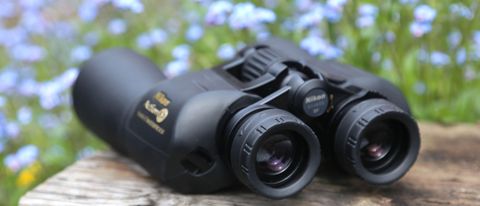Space Verdict
The Nikon Action EX 12x50 is a step-up from the mass market, with a little extra magnification, excellent light-gathering and rugged construction that extends to waterproofing, comfy rubber grips and a large focus knob. Yet it's a heavyweight in more ways than one.
Pros
- +
Non-slip waterproof design
- +
Wide field of view
- +
Clear and crisp observations
- +
Impressive build quality
- +
Excellent value
Cons
- -
Relatively heavy
- -
Closest focus is 23 feet/7m
- -
Slight field curvature
- -
Objective lens caps easy to lose
Why you can trust Space.com
Some say that binoculars are an astronomer's best friend, largely because they're much easier to handle than a telescope. The Nikon Action EX 12x50 is undoubtedly more portable than a telescope, but it's not exactly lightweight. Based on the larger porro prism design of binoculars, Nikon has favored a tough, waterproof and likely drop-proof build that should allow the Nikon Action EX 12x50 to last for years. But at what cost? A heavy binocular at 2.3 lbs/1kg, could the extra heft mean that the Nikon Action EX 12x50s are harder to hold steady than its rivals? When stargazing, that's critically important, but there's something else about the Nikon Action EX 12x50 that could make stable stars even more difficult.
Magnification: 12x
Objective lens diameter: 50mm
Angular field of view: 5.5 degrees
Eye relief: 0.63-inch/16.1mm
Weight: 36.8oz/1kg
With 12x magnification, you get a more detailed view than on many 10x rivals, but you'll also likely see any shakiness magnified. However, in practice, the Nikon Action EX 12x50 gets through these issues, or, at least, makes up for them and takes its place in our best binoculars collection. Here's why we think the impressive and reliable Nikon Action EX 12x50 makes a wise investment for anyone looking for a pair of binoculars that are built for the long-term and that will let you see deep into the cosmos.
Nikon Action EX 12x50 binoculars: Design
- Porro prisms
- BaK-4 glass optics
- Tough waterproof rubber armor
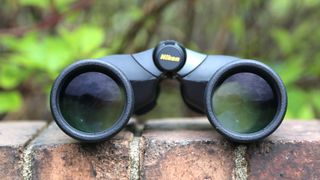
The Nikon Action EX 12x50 are porro prism binoculars, which once dominated the market yet now form the basic design of the minority of binoculars. That's mainly down to portability. After all, the Nikon Action EX 12x50 has two tubes set far apart, with a Z-shape to the light entering their objective lenses. On the Nikon Action EX 12x50 that means a relatively wide design that can't be folded into a compact shape, as roof prism rivals can, and a total weight of 36.8 oz/1kg. For context, a similarly priced pair of roof prism binoculars shave at least a third off that. So why has Nikon chosen porro prism for these binoculars? Brightness. Porro prism binoculars generally need fewer fancy lens coatings to achieve a bright, detailed image, which is why the Nikon Action EX 12x50s are so cost-effective.
Not that they don't have lens coatings. The Nikon Action EX 12x50 boasts multicoated lenses and BaK-4 glass prisms, the former being a run-of-the-mill feature and the latter being a more prominent mark of quality.
Objective lens caps
Rainguard for eyecups
Neck strap
Padded carry case
Elsewhere, the Nikon Action EX 12x50 impresses — with that rubber armor, in particular, a standout feature. Nicely textured to make them easy to hold in all kinds of weather conditions, the Nikon Action EX 12x50s are also waterproof. A couple of loops are built-in to the design for attaching a neck strap in the box. It's good quality and has a soft leather patch where it rests on the neck.
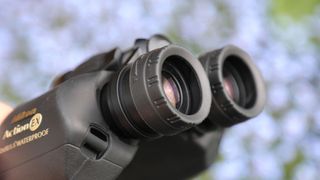
The central focus knob between the tubes has a ridged rubber covering to make it easy to use with gloves. So too does the diopter wheel, which lets the binoculars compensate for differences between your eyes and achieve a focus that suits you.
If you are worried about shaky views then know that the Nikon Action EX 12x50 does have a thread for a tripod adaptor hidden behind a small Nikon logo behind the focus wheel. Normally we wouldn't expect it to ever be used, but it may occasionally come in handy for long observing sessions using the Nikon Action EX 12x50.
Nikon Action EX 12x50 binoculars: Performance
- Excellent light gathering
- Sharp optics
- 23 feet/7m close focus
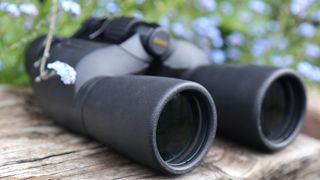
Nikon Action EX 12x50 binoculars are not particularly good for using close-up. You can focus on something a minimum of 23 ft/7m away, which isn't helpful if you're bird-watching in your back garden. However, the Nikon Action EX 12x50 excels at safari and stargazing. The 50mm objective lenses let enough light in to offer bright views during dawn and dusk and starlight at night. That 12x magnification doesn't mean a drop in brightness.
Although it's impossible to see much detail in the giant planet's cloud-tops, we could easily discern Jupiter's four big moons Ganymede, Europa, Callisto and Io. When trained on Polaris, the North Star, we were treated to a sharp view of the 'engagement ring' of nine stars around it. Ditto the stars of the Beehive Cluster in Cancer, from which we got immersive and contrast-heavy views, with only a slight drop in sharpness detectable towards the edge of the field of view. It's barely noticeable, only being an issue when sweeping the Nikon Action EX 12x50 binoculars across the rich star fields of the Milky Way.
Nikon Action EX 12x50 binoculars: Functionality
- Non-slip rubber armor
- Objective lens caps are easy to lose
- Rather heavy
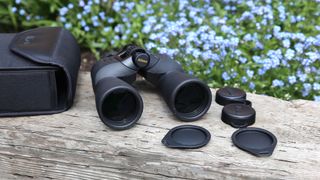
The Nikon Action EX 12x50 binos are relatively heavy, however, there's no doubt that they are made for travel and for the outdoors. Its rubber armor is excellent, well-fitting and adds peace of mind that they're not going to get damaged.
Techniques to keep views steady when using heavy binoculars include leaning back against a wall while observing (which is remarkably effective) or sitting in a lawn chair while observing (even better). Hold them close to the barrels when observing something on the horizon and closer to your eyes when observing objects halfway up the sky.
Something we're not keen on is the objective lens caps worn by the Nikon Action EX 12x50. They pop into place perfectly well, but what do you do with them when observing? Small black plastic accessories and nighttime don't mix well. We would prefer to have the lens caps permanently attached and hanging down when the Nikon Action EX 12x50s are being used.
For wearers of spectacles, the Nikon Action EX 12x50s have 0.63-inch/16.1mm eye relief, which is just about enough for a reasonably immersive view. The eyecups themselves have a solid feel and click definitively into three positions, while the diopter wheel is smooth but resistant to being easily knocked out of place.
Should you buy the Nikon Action EX 12x50 binoculars?
The Nikon Action EX 12x50 is right at the limit. An attractive package of excellent build quality and reliable optics, the Nikon Action EX 12x50 binoculars are nevertheless at the heavy end of what we consider easily handled binoculars for long stargazing sessions.
The 12x magnification alone means inherent unsteadiness compared with 10x rivals. What's more, at 36.8 oz/1kg, it's necessary to employ a few tried and tested techniques to keep their clean, crisp and bright views still enough to properly appreciate, not least of all the possibility of mounting them on a tripod. However, the Nikon Action EX 12x50 remains a heavyweight in all regards, with excellent outdoorsy build quality and reliable optics that make them highly recommended.
If the Nikon Action EX 12x50 binoculars aren't for you:
If you want something significantly lighter than the Nikon Action EX 12x50, then consider a pair of roof prism binoculars like the Celestron TrailSeeker 8x42, which weigh in at just 23.1 oz/654g. However, they do offer less magnification and smaller objective lens size. For something significantly more expensive and with even better optics, but with built-in image stabilization to counteract their even heavier 39.2 oz/1.1kg bulk, the Canon 10x42L IS WP comes highly recommended for astronomy and wildlife. For something completely different that will get you a much wider field of view and a much simpler, more lightweight 14.5 oz/411g construction, look at the Vixen SG 2.1x42 constellation binoculars.
Join our Space Forums to keep talking space on the latest missions, night sky and more! And if you have a news tip, correction or comment, let us know at: community@space.com.

Jamie is an experienced science, technology and travel journalist and stargazer who writes about exploring the night sky, solar and lunar eclipses, moon-gazing, astro-travel, astronomy and space exploration. He is the editor of WhenIsTheNextEclipse.com and author of A Stargazing Program For Beginners, and is a senior contributor at Forbes. His special skill is turning tech-babble into plain English.
